2. Department of Automation, Shanghai Jiao Tong University, and Key Laboratory of System Control and Information Processing, Ministry of Education of China, Shanghai 200240, China;
3. Institute of Electrical Engineering, Yanshan University, Qinhuangdao 066004, China;
4. Institute of Electrical Engineering, Yanshan University, Qinhuangdao 066004, China;
5. Department of Automation, Shanghai Jiao Tong University, and Key Laboratory of System Control and Information Processing, Ministry of Education of China, Shanghai 200240, China
BILATERAL teleoperation system has become an active area of research and attracted multi-disciplinary researchers including scientists in system control theory,statistical physicists,biologists,clinicians,etc. A bilateral teleoperator is typically composed of five interconnected elements: the human operator,the master robot,the communication network,the slave agent (e.g.,unmanned ground vehicle,unmanned aerial vehicle and unmanned underwater vehicle) and the environment. The application of such a system spans multiple fields such as space and undersea explorations,handling with hazardous objects and robotic telesurgery (see [1, 2, 3] and references therein).
With the introduction of communication network into teleoperation system,time delays are unavoidable when data information is back and forth between the master robot and slave agent. These time delays can affect the whole stability of the system,and therefore many researchers have considered their influence. Based on passivity and input to state stable (ISS) theories,the stability analysis and controller design problems were extensively studied in [4, 5, 6]. The symmetric and constant time delays were investigated,and an effective stability criteria was presented in [7]. Recently,the stability analysis problem with asymmetric and time-varying delays was considered in [8, 9, 10]. However,these research efforts were well framed under the assumption that the configuration of teleoperation system was single-master-single-slave. Because of the increasing complexity of tasks,"multi-agent systems" [11, 12] should be applied to the teleoperation system,i.e.,multiple slave agents are required in the future developments of teleoperation systems. Compared with single-master-single-slave system,teleoperation of multiple slave agents can complete multiple tasks in a shorter time,cover larger-scaled areas,and adapt more easily to single point failure. With these abilities,formation of a single-master-multi-slave teleoperation system provides the capacity of cooperatively performing challenging tasks in a team, such as search and rescue,reconnaissance,surveillance and earth magnetic field study. Due to the complexity of modelling and coupling,there are few research efforts on the single-master-multi-slave teleoperation systems. More recently,a multi-slave teleoperation system based on bearing only measurements was developed in [13]. In [14],bilateral teleoperation of a formation of car-like planetary rovers under communication delays was addressed. Yet,the detailed stability conditions were not given in these papers. Moreover,[15] designed a passifying proportional-derivative controller and gave the stability conditions. However,the time delays were constant and the gravitational force was omitted in the dynamics formulation. To the best of our knowledge,cooperation control of multi-slave teleoperation system with time-varying delays has been received less attention.
On the other hand,most of the results mentioned above assume that all data transmissions can be performed with infinite precision, but the effect of the data quantization is ignored. Due to the limited transmission capacity of the network and some devices in the closed-loop systems (such as A/D and D/A converters),data transmitted in a practical teleoperation system should be quantized before being sent to the next network node. In the existing literature,to the best of our knowledge,there is yet no serious effort to investigate the quantization problem while considering the multi-slave teleoperation system with variable time delays.
This paper attempts to overcome these limitations by applying "multi-agent systems" to the teleoperation system. Additionally, the configuration of networked teleoperation system is extended to single-master-multi-slave. Then,a novel master-slave formation protocol is proposed for single-master-multi- slave teleoperation system with time-varying delays and quantization. The performance goals are to ensure boundedness of the state tracking error between the master robot and slave agents when slave agents are in hard contact with the environment,and to achieve the formation when slave agents are allowed to move freely. Finally,the sufficient conditions for stability are also given,and the closed-loop multi-slave bilateral teleoperation system is proved to be convergent. By operating the master robot,humans can control the overall behavior of slave agents while perceiving combined environmental forces on them. The main contributions of this paper are twofold.
1) Compared with the previous work,both quantization and time-varying delays are considered. Then,a dynamic quantization measurement is proposed to quantize the output signals.
2) Multi-agent systems are applied to the slave site,then a teleoperation system is considered. Correspondingly,a novel master-slave formation protocol is proposed for master robot and slave agents.
Notation. ${\bf R}^{n}$ denotes the $n$-dimensional Euclidean space,${\bf R}^{n\times n}$ is the set of $n\times n$ real matrices,$I$ is the identity matrix of appropriate dimension,$\left\Vert \cdot \right\Vert$ stands for the the $\mathcal{L}_{2}$ norm,and $\left\vert \cdot \right\vert $ for the Euclidean norm. The notation $X > 0$ (or $X\geq 0$),for $X\in{\bf R}^{n\times n}$,means that matrix $X$ is a real symmetric positive definite (or positive semi-definite).
Ⅱ.Problem formulationConsider the task of remotely controlling a formation of $N$ $n$-degree-of-freedom (DOF) slave agents coupled bilaterally through $N$ variable time delayed communication channels to a single $n$-DOF master robot. Their corresponding non-linear Lagrangian dynamics is described by
| $\left\{ {\begin{array}{*{20}{l}} {{M_m}({q_m}){{\ddot q}_m} + {C_m}({q_m},{{\dot q}_m})\dot q{\% _m} + {g_m}({q_m}) = {\tau _m} - {F_h},}\\ {{M_1}({q_1}){{\ddot q}_1} + {C_1}({q_1},{{\dot q}_1}){{\dot q}_1} + {g_1}({q_1})\% = {\tau _1} + {F_1},}\\ {\quad \;\,\quad \;\,\;\;\, \vdots }\\ {{M_N}({q_N}){{\ddot q}_N} + {C_N}({q_N},{{\dot q}_N}){{\dot q}_N} + {g_N}({q_N})\% = {\tau _N} + {F_N},} \end{array}} \right.$ | (1) |
where1 ${\ddot q_i},{\dot q_i},{q_i} \in {R^n}$ are the acceleration,velocity and position,respectively,${M_i}({q_i}) \in {{\bf{R}}^{n \times n}}$ is the positive definite inertia matrix,$C_{i}(\pmb q_{i},\dot{\pmb q}% _{i})\in {\bf R}^{n\times n}$ is the centrifugal and Coriolis matrix,$g_{i}(\pmb q_{i})\in {\bf R}^{n}$ is the gravitational force,${\tau _i} \in {{\bf{R}}^n}$ is the control torque, ${F_h}\in {\bf R}^{n}$ is the human force,and ${F_i} \in {{\bf{R}}^n}$ is the environment force. Here,$i=m$ represents the master robot and $% i=1,\cdots ,N$ represents the $i$th slave agent.
The above model has some important properties[16].
Property 1. The inertia matrix is lower and upper bounded,i.e.,
| $0< \lambda _{\min }(M_{i}(\pmb q_{i}))I\leq M_{i}(\pmb q_{i})\leq \lambda _{\max }(M_{i}(\pmb q_{i}))I <\infty,$ | (2) |
where $\lambda _{\min }$ and $\lambda _{\max }$ are the minimum and maximum eigenvalues of matrix $M_{i}(\pmb q_{i})$, respectively.
Property 2. The Coriolis and inertia matrices are related as
| $\dot{M}_{i}(\pmb q_{i})=C_{i}(\pmb q_{i},\dot{\pmb q}_{i})+C_{i}^{\text{T}}(\pmb q_{i},\dot{\pmb q}% _{i}).$ | (3) |
Property 3. There exists a positive scalar $\beta _{i}$ such that $U_{i}(\pmb q_{i})\geq \beta _{i}$,where $U_{i}(\pmb q_{i})$ is the potential energy of the manipulator satisfying $g_{i}(\pmb q_{i})=\partial U_{i}(\pmb q_{i})/\partial \pmb q_{i}$.
Property 4. For all $\pmb q_{i},\pmb x,\pmb y\in {\bf R}^{n}$,there exists a positive scalar $\varsigma _{i}$ such that $\left\Vert C_{i}(\pmb q_{i},\pmb x)\pmb y\right\Vert $ $\leq \varsigma _{i}\left\Vert \pmb x\right\Vert \left\Vert \pmb y\right\Vert .$
For stability analysis,the following lemmas and assumptions are used.
Lemma 1[9] For any vector signals $\pmb x$,$\pmb y$,variable time delay $0\leq d(t)\leq \tilde{T}< \infty ,$ and any constant $\bar{\varsigma}>0,$ one has
| $-2\int\nolimits_{0}^{t}\pmb x^{\text{T}}(\sigma )\int\nolimits_{-d(\sigma )}^{0}\pmb y(\sigma +\theta ){\rm d}\theta {\rm d}\sigma \leq \bar{\varsigma}\left\Vert \pmb x\right\Vert ^{2}+\frac{\tilde{T}^{2}}{\bar{\varsigma}}\left\Vert \pmb y\right\Vert ^{2}.$ | (4) |
Lemma 2[9] Consider a robot manipulator in the form of (1). If $\pmb q_{i},\ddot{\pmb q}_{i}\in \mathcal{L}_{\infty }$,then $\dot{C}% (\pmb q_{i},\dot{\pmb q}_{i})\in \mathcal{L}_{\infty }.$
Assumption 1. The human operator and the environment are passive where $i=1,\cdots ,N$,i.e.,
| $\int\nolimits_{0}^{t}\dot{\pmb q}_{m}^{\text{T}}(\sigma ){\pmb F}_{h}(\sigma ){\rm d}\sigma \geq 0,\int\nolimits_{0}^{t}-\dot{\pmb q}_{i}^{\text{T}}(\sigma ){\pmb F}_{i}(\sigma ){\rm d}\sigma \geq 0.$ | (5) |
Assumption 2. The time delays $d_{mi}(t)$ and $d_{im}(t)$ are bounded,where $d_{im}(t)$ is the time-varying delay from slave agent $i$ to the master site,and $d_{mi}(t)$ is the time-varying delay from the master to slave agent $i$. Then,there exists a positive scalar $\tilde{T}$ such that $% d_{mi}(t)\leq \tilde{T}$ and $d_{im}(t)\leq \tilde{T}$ for $i=1,\cdots ,N.$
Measurement and control signals are required to be quantized before transmission. The quantization strategies,which convert a real-valued signal into a piecewise constant one taken from a finite set of values,are generally categorized into static and dynamic ones. The static strategy[17] presumes that data quantization at time $k$ is only dependent on the data at time $k$. The attraction of static quantizer is simplicity of its coding/decoding schemes. But it requires an infinite number of quantization bits to ensure asymptomatic stability. To relax this restriction,dynamic quantization strategy may be a good choice[18, 19, 20]. It has the advantage to scale the quantization levels dynamically in order to increase the region of attraction and to attenuate the steady state limit cycle. In some literature, most employed dynamic quantizers use dynamic scaling in conjunction with a static quantizer.
Let $\pmb {z}\in {\bf R}^{n}$ be a variable to be quantized. Quantizer $f(\cdot )$ is defined as a piecewise constant function $f:% {\bf R}^{n}\rightarrow {\bf Q}$,where $% {\bf Q}$ is a finite subset of $% {\bf R}^{n}.$ This leads to a partition of $% {\bf R}^{n}$ into a finite number of quantization regions in the form of $\{\pmb {z}\in {\bf R}^{n}:f(\pmb {z})={\pmb \vartheta} \},$ ${\pmb \vartheta} \in {\bf Q}.$ When $\pmb {z}$ does not belong to the union of a finite number of quantization regions,the quantizer saturates. More precisely,it is assumed that there exist positive real numbers $H$ and $\Delta $ such that the following two conditions hold:
| $\begin{array}{l} {\rm{If}}\left| z \right| \le H,{\rm{then}}\left| {f\left( z \right) - z} \right| \le \Delta ,\\ {\rm{and}}\;{\rm{if}}\left| z \right| > H,{\rm{then}}\left| {f\left( z \right)} \right| > H - \Delta . \end{array}$ | (6) |
The first condition gives a bound of the quantization error when the quantizer does not saturate,and the second condition provides a way to detect the possibility of saturation. $H$ and $\Delta $ are considered as the quantization range and error of $f(\cdot )$,respectively.
In the control strategies to be developed below,quantized measurements have the following form:
| $f_{\mu }(\pmb {z})=\mu f\left( \frac{\pmb {z}}{\mu }\right),$ | (7) |
where $\mu >0$. The range of the quantizer and the quantization error are $% H\mu $ and $\Delta \mu $,respectively. $\mu $ is referred to as the "zoom" variable; increasing $\mu $ corresponds to zooming out and essentially obtaining a new quantizer with a larger range and quantization error,whereas decreasing $\mu $ corresponds to zooming in and obtaining a quantizer with a smaller range but also a smaller quantization error.
Given the above discussions,the formation control problem can now be stated as follows.
Problem 1. Considering the scenario of remotely controlling a multi-slave bilateral teleoperation system with both quantization and time-varying delays,this paper seeks to design a master-slave formation protocol,such that the master robot can track the centroid of slave agents,while each slave agent can keep a desired relative position vector with the master robot.
Remark 1. In single-master-single-slave teleoperation system[4, 9, 10],the human operator manipulates the master to simulate the motion. The position and velocity signals are then sent to the slave agent so that it can track the motion of the master robot. But it is not simple to track the master$'$s trajectory,because the effect of environment force is also transmitted back to the master robot,so the teleoperator is said to be controlled bilaterally. In this paper,the single-master-multi-slave teleoperation system is considered. In order to track the motion of the master robot,each slave agent should interact with the master robot,while keeping a desired position vector with the master robot. Correspondingly,the master robot is required to control the central location of the formation. Obviously,a simple and effective way is to track the centroid of slave agents for the master robot. Therefore,the above formation objective satisfies the requirement of bilateral teleoperation,and similar formation objective can also be found in [15].
Ⅲ. MAIN RESULTSIn this section,the formation protocol is designed such that system (1) is closed-loop stable when enforced master-to-slaves position convergence and static force reflection. By formation control,slave agent $i$ maintains a desired relative position vector $\pmb \gamma _{i}\in {\bf R}^{n}$ from the formation$'$s geometric center,i.e.,$\pmb q_{i}\rightarrow \frac{1% }{N}\sum_{i=1}^{N}\pmb q_{i}-\pmb \gamma _{i},$ $\forall i=1,\cdots,N.$ Meanwhile,these slave agents should track the master robot,so the geometric center of the formation is required to converge to the position of the master robot,i.e., $\frac{1}{N}\sum_{i=1}^{N}\pmb q_{i}\rightarrow \pmb q_{m}.$ Accordingly,the formation protocol for the master and slave agent $i$ ($\forall i=1,\cdots ,N $) is designed as
| ${\pmb \tau}_{m} =-k[\pmb q_{m}-\tfrac{1}{N}(\sum\nolimits_{i=1}^{N}f_{\mu _{i}}(\pmb q_{i}(t-d_{im}(t))))]-\alpha _{m}\dot{\pmb q}_{m},\notag \\ {\pmb \tau}_{i} =k[f_{\mu _{m}}(\pmb q_{m}(t-d_{mi}(t)))-\pmb q_{i}-\pmb \gamma _{i}]-\alpha _{s}\dot{\pmb q}_{i},$ | (8) |
where $k > 0$ is the proportional coefficient,$\alpha _{m}>0$ and $\alpha _{s}>0$ are damping coefficients,$f_{\mu _{i}}$ and $f_{\mu _{m}}$ are quantization strategies,and $\pmb {\gamma }_{i}\in {\bf R}^{n}$ is the desired relative position vector. The control framework is shown in Fig. 1.

|
Download:
|
| Fig. 1. Control framework of the networked teleoperation system. | |
With (1) and (8),the controlled system is rearranged as
| $\left\{\begin{array}{*{20}l} M_{m}(\pmb q_{m})\ddot{\pmb q}_{m}+C_{m}(\pmb q_{m},\dot{\pmb q}_{m})\dot{\pmb q}% _{m}+g_{m}(\pmb q_{m})+{\pmb F}_{h} =\\ \quad -k[\pmb q_{m}-\tfrac{1}{N}(\sum\nolimits_{i=1}^{N}f_{\mu _{i}}(\pmb q_{i}(t-d_{im}(t))))]-\alpha _{m}\dot{\pmb q}_{m},\\ M_{1}(\pmb q_{1})\ddot{\pmb q}_{1}+C_{1}(\pmb q_{1},\dot{\pmb q}_{1})\dot{\pmb q}% _{1}+g_{1}(\pmb q_{1})-{\pmb F}_{1} = \\ \quad k[f_{\mu _{m}}(\pmb q_{m}(t-d_{m1}(t)))-\pmb q_{1}-\pmb \gamma _{1}]-\alpha _{s}\dot{\pmb q}% _{1},\\ \qquad \qquad\quad \vdots \\ M_{N}(\pmb q_{N})\ddot{\pmb q}_{N}+C_{N}(\pmb q_{N},\dot{\pmb q}_{N})\dot{\pmb q}% _{N}+g_{N}(\pmb q_{N})-{\pmb F}_{N}= \\ \quad k[f_{\mu _{m}}(\pmb q_{m}(t-d_{mN}(t)))-\pmb q_{N}-\pmb \gamma _{N}]-\alpha _{s}\dot{\pmb q}% _{N}.\end{array}\right.$ | (9) |
In the following,the stability analysis of the closed-loop system (9) is provided.
Theorem 1. For the single-master-multi-slave teleoperation system (9) with the control scheme (8),if there exist positive constants $k,$ $\alpha _{m},$ $\alpha _{s},$ $\tilde{T},$ $\bar{\varsigma}% _{m},$ $\bar{\varsigma}_{i},$ $H_{m},$ $H_{i},$ $\triangle _{m},$ $\triangle _{i}$ $(i=1,\cdots ,N)$,such that
| $\alpha _{m}-\dfrac{k\bar{\varsigma}_{m}}{2}-\dfrac{k\tilde{T}^{2}}{2\bar{% \varsigma}_{i}} >0,\text{ }\alpha _{s}-\dfrac{k\bar{\varsigma}_{i}}{2}-% \dfrac{k\tilde{T}^{2}}{2\bar{\varsigma}_{m}}>0,$ | (10) |
| ${H_m} - \frac{{k{\Delta _m}}}{{{\alpha _s}{\rm{ - }}\frac{{{\rm{k}}{{\overline {\% \varsigma } }_{\rm{i}}}}}{{\rm{2}}}{\rm{ - }}\frac{{{\rm{k}}{{{\rm{\tilde T}}}^{\rm{2}}}}}{{{\rm{2}}{{\bar \varsigma }_{\rm{m}}}\% }}}} > 0,{H_i} - \frac{{k{\Delta _i}}}{{{\alpha _m}{\rm{ - }}\frac{{{\rm{k}}\% {{\bar \varsigma }_{\rm{m}}}}}{{\rm{2}}}{\rm{ - }}\frac{{{\rm{k}}{{{\rm{\tilde T}}}^{\rm{2}}}}}{{{\rm{2}}{{\overline {\varsigma \% } }_{\rm{i}}}}}}} > 0,$ | (11) |
then the closed-loop system (9) is stable,the velocities $\dot{\pmb q}_{m}$, $\dot{\pmb q}_{i}$,formation error $\pmb q_{m}-\pmb q_{i}-\pmb \gamma _{i},$ and tracking error $\pmb q_{m}-\frac{1}{N}\sum\nolimits_{i=1}^{N}\pmb q_{i}$ are bounded.
Proof. We choose the following Lyapunov function:
| $V=V_{m}+V_{s},$ | (12) |
where
| $V_{m} =\tfrac{N}{2}\dot{\pmb q}_{m}^{\text{T}}M_{m}(\pmb q_{m})\dot{\pmb q}% _{m}+\sum\nolimits_{i=1}^{N}\tfrac{1}{2}\dot{\pmb q}_{i}^{\text{T}}M_{i}(\pmb q_{i})% \dot{\pmb q}_{i} + \nonumber\\ \qquad N(U_{m}(\pmb q_{m})-\beta _{m})+\sum\nolimits_{i=1}^{N}(U_{i}(\pmb q_{i})-\beta _{i})+ \\ \qquad \sum\nolimits_{i=1}^{N}\int\nolimits_{0}^{t}(\dot{\pmb q}_{m}^{\text{T}% }(\sigma ){\pmb F}_{h}(\sigma )-\dot{\pmb q}_{i}^{\text{T}}(\sigma ){\pmb F}_{i}(\sigma )){\rm d}\sigma,\\ V_{s}=\sum\nolimits_{i=1}^{N}\tfrac{k}{2}(\pmb q_{m}-\pmb q_{i}-\pmb \gamma _{i})^{\text{T}% }(\pmb q_{m}-\pmb q_{i}-\pmb \gamma _{i}).$ |
From Property 3 and Assumption 1,one has $U_{m}(\pmb q_{m})-\beta _{m}>0,$ $% U_{i}(\pmb q_{i})-\beta _{i}>0$ and $\int\nolimits_{0}^{t}(\dot{\pmb q}_{m}^{\text{T}% }(\sigma ){\pmb F}_{h}(\sigma )-\dot{\pmb q}_{i}^{\text{T}}(\sigma){\pmb F}_{i}(\sigma )){\rm d}\sigma >0,$ then $V>0.$
In Property 3,$g_{i}(\pmb q_{i})=\partial U_{i}(\pmb q_{i})/\partial \pmb q_{i}$ and $% g_{m}(\pmb q_{m})=\partial U_{m}(\pmb q_{m})/\partial \pmb q_{m}$. Then time derivative of $% V$ is
| $\dot{V} =\ N\dot{\pmb q}_{m}^{\text{T}}[{\pmb \tau}_{m}-{\pmb F}_{h}-C_{m}(\pmb q_{m},\dot{\pmb q}_{m})% \dot{\pmb q}_{m}-g_{m}(\pmb q_{m})] + \notag \\ \tfrac{N}{2}\dot{\pmb q}_{m}^{\text{T}}\dot{M}_{m}(\pmb q_{m})\dot{\pmb q}_{m}+N\dot{\pmb q}% _{m}^{\text{T}}g_{m}(\pmb q_{m}) + \notag \\ \sum\nolimits_{i=1}^{N}[\dot{\pmb q}_{i}^{\text{T}}({\pmb \tau} _{i}+{\pmb F}_{i}-C_{i}(\pmb q_{i},\dot{\pmb q}_{i})\dot{\pmb q}_{i}-g_{i}(\pmb q_{i}))]+ \notag \\ \sum\nolimits_{i=1}^{N}\tfrac{1}{2}\dot{\pmb q}_{i}^{\text{T}}\dot{M}% _{i}(\pmb q_{i})\dot{\pmb q}_{i}+\sum\nolimits_{i=1}^{N}\dot{\pmb q}_{i}^{\text{T}% }g_{i}(\pmb q_{i}) + \notag \\ N\dot{\pmb q}_{m}^{\text{T}}{\pmb F}_{h}-\sum\nolimits_{i=1}^{N}\dot{\pmb q}_{i}^{\text{T}% }{\pmb F}_{i}+k\sum\nolimits_{i=1}^{N}[\dot{\pmb q}_{m}^{\text{T}}\pmb q_{m} -\notag \\ \dot{\pmb q}_{m}^{\text{T}}\pmb q_{i}-\dot{\pmb q}_{m}^{\text{T}}\pmb \gamma _{i}-\dot{\pmb q}% _{i}^{\text{T}}\pmb q_{m}+\dot{\pmb q}_{i}^{\text{T}}\pmb q_{i}+\dot{\pmb q}_{i}^{\text{T}% }\pmb \gamma _{i}].$ |
If $\Xi \in {\bf R}^{n\times n}$ is a skew-symmetric matrix,one has $\pmb x^{\text{T}}\Xi \pmb x=0$ for any vector $\pmb x\in {\bf R}^{n}.$ By this character and the matrix relation in Property 2, (13) is rearranged as
| $\dot{V} =~N\dot{\pmb q}_{m}^{\text{T}}{\pmb \tau}_{m}+\sum\nolimits_{i=1}^{N}\dot{\pmb q}% _{i}^{\text{T}}{\pmb \tau}_{i}+k\sum\nolimits_{i=1}^{N}[\dot{\pmb q}_{m}^{\text{T}% }\pmb q_{m}- \notag \\ \dot{\pmb q}_{m}^{\text{T}}\pmb q_{i}-\dot{\pmb q}_{m}^{\text{T}}\pmb \gamma _{i}-\dot{\pmb q}% _{i}^{\text{T}}\pmb q_{m}+\dot{\pmb q}_{i}^{\text{T}}\pmb q_{i}+\dot{\pmb q}_{i}^{\text{T}% }\pmb \gamma _{i}]= \notag \\ \dot{\pmb q}_{m}^{\text{T}}\sum\nolimits_{i=1}^{N}[kf_{\mu _{i}}(\pmb q_{i}(t-d_{im}(t)))-\alpha _{m}\dot{\pmb q}_{m}] + \notag \\ k\sum\nolimits_{i=1}^{N}(-\dot{\pmb q}_{m}^{\text{T}}\pmb q_{i}-\dot{\pmb q}_{i}^{\text{% T}}\pmb q_{m}-\dot{\pmb q}_{m}^{\text{T}}\pmb \gamma _{i}) + \notag \\ \sum\nolimits_{i=1}^{N}\dot{\pmb q}_{i}^{\text{T}}[kf_{\mu _{m}}(\pmb q_{m}(t-d_{mi}(t)))-\alpha _{s}\dot{\pmb q}_{i}] = \notag \\ k\dot{\pmb q}_{m}^{\text{T}}\sum\nolimits_{i=1}^{N}[f_{\mu _{i}}(\pmb q_{i}(t-d_{im}(t)))-\pmb q_{i}(t-d_{im}(t))]+ \notag \\ k\sum\nolimits_{i=1}^{N}\dot{\pmb q}_{i}^{\text{T}}[f_{\mu _{m}}(\pmb q_{m}(t-d_{mi}(t))) - \notag \\ \pmb q_{m}(t-d_{mi}(t))]+k\sum\nolimits_{i=1}^{N}\dot{\pmb q}_{i}^{\text{T}% }[\pmb q_{m}(t-d_{mi}(t)) - \notag \\ \pmb q_{m}]-\alpha _{m}N\dot{\pmb q}_{m}^{\text{T}}\dot{\pmb q}_{m}+k\dot{\pmb q}_{m}^{\text{T% }}\sum\nolimits_{i=1}^{N}[\pmb q_{i}(t-d_{im}(t)) - \notag \\ \pmb q_{i}-\pmb \gamma _{i}]-\alpha _{s}\sum\nolimits_{i=1}^{N}\dot{\pmb q}_{i}^{\text{T% }}\dot{\pmb q}_{i}.$ | (14) |
From (6) and (7),one can obtain $\left\vert (\pmb q_{m}(t-d_{mi}(t)))/\mu _{m}\right\vert \leq H_{m}$ and $\left\vert (\pmb q_{i}(t-d_{im}(t)))/\mu _{i}\right\vert \leq H_{i}$,where $\mu _{m}>0$ and $% \mu _{i}>0.$ For the master,the range of quantizer is $H_{m}\mu _{m}$ and the quantization error is $\triangle _{m}\mu _{m}.$ For slave $i$,the range of quantizer is $H_{i}\mu _{i}$ and quantization error is $\triangle _{i}\mu _{i}.$ Then,one has
| $\begin{array}{l} \left| {{f_{{\mu _m}}}({q_m}(t - {d_{mi}}(t))) - {q_m}(t - {d_{mi}}(t))} \right| = \\ \left| {{\mu _m}\left( {f\left( {\frac{{{q_m}(t - {d_{mi}}(t))}}{{{\mu _m}}}\% } \right) - \frac{{{q_m}(t - {d_{mi}}(t))}}{{{\mu _m}}}} \right)} \right| \le {\Delta _m}{\mu _m}, \end{array}$ | (15) |
| $\begin{array}{l} \left| {{f_{{\mu _i}}}\left( {{q_i}\left( {t - {d_{im}}\left( t \right)} \right)} \right) - {q_i}\left( {t - {d_{im}}\left( t \right)} \right)} \right| = \\ \left| {{\mu _i}\left( {f\left( {\frac{{{q_i}\left( {t - {d_{im}}\left( t \right)} \right)}}{{{\mu _i}}}\% } \right) - \frac{{{q_i}\left( {t - {d_{im}}\left( t \right)} \right)}}{{{\mu _i}}}} \right)} \right| \le {\Delta _i}{\mu _i}. \end{array}$ | (16) |
Noticing $\pmb q_{m}(t-d_{mi}(t))-\pmb q_{m}=-\int_{-\pmb d_{mi}(t)}^{0}\dot{\pmb q}_{m}(t+\theta ){\rm d}\theta $ and $\pmb q_{i}(t-d_{im}(t))-\pmb q_{i}=-\int_{-d_{im}(t)}^{0}\dot{\pmb q}% _{i}(t+\theta ){\rm d}\theta ,$ one has
| $\begin{array}{l} \dot V \le k\left| {{{\dot q}_m}} \right|\sum\nolimits_{i = 1}^N {{\Delta _i}} {\mu _i} + k{\Delta _m}{\mu _m}\sum\nolimits_{i = 1}^N {\left| {{{\dot q}_i}} \right|} - \\ k\sum\nolimits_{i = 1}^N {\dot q_i^T} \int_{ - {d_{mi}}(t)}^0 \% {{\dot q}_m}(t + \theta ){\rm{d}}\theta - \\ k\dot q_m^{\rm{T}}\sum\nolimits_{i = 1}^N {\int_{ - {d_{im}}(t)}^0 {{{\dot q}_i}} } \left( {t + \theta } \right){\rm{d}}\theta - \\ {\alpha _m}N{\left| {{{\dot q}_m}} \right|^2} - {\alpha _s}\sum\nolimits_{i = 1}^N {{{\left| {{{\dot q}_i}} \right|}^2}} . \end{array}$ | (17) |
By Lemma 1,one can obtain the following judgements: $ - 2\int_0^t {\dot q} \% _m^{\rm{T}}\left( \sigma \right){\int_{ - {d_{im}}}^0 {\dot q} _i}\left( {t + \theta } \right){\rm{d}}\theta {\rm{d}}\sigma \le {\bar \varsigma _m}{\left| {{{\dot q}_m}} \right|^2} + \% \frac{{{{\tilde T}^2}}}{{{{\bar \varsigma }_m}}}{\left| {{{\dot q}_i}} \right|^2}$ and $ - 2\int_0^t {\dot q_i^{\rm{T}}} \left( \sigma \right)\int_{ - {d_{mi}}(t)}^0 {{{\dot q}_m}} \left( {t + \theta } \right){\rm{d}}\theta {\rm{d}}\sigma \le {\overline {\% \varsigma } _i}{\left| {{{\dot q}_i}} \right|^2} + \frac{{{{\tilde T}^2}}}{{\% {{\bar \varsigma }_i}}}{\left| {{{\dot q}_m}} \right|^2}$. Then,after integrating (17) from zero to $t$,the derivative of $V$ is
| $\dot{V} \leq ~-\sum\nolimits_{i=1}^{N}(\alpha _{m}-\frac{k\bar{\varsigma}% _{m}}{2}-\frac{k\tilde{T}^{2}}{2\bar{\varsigma}_{i}})\left\vert \dot{\pmb q}% _{m}\right\vert \times \left(\left\vert \dot{\pmb q}_{m}\right\vert-\right. \notag \\ \left.\frac{k\triangle _{i}\mu _{i}}{\alpha _{m}-\frac{k\bar{\varsigma}_{m}}{2}-% \frac{k\tilde{T}^{2}}{2\bar{\varsigma}_{i}}}\right)-\sum\nolimits_{i=1}^{N}(% \alpha _{s}-\dfrac{k\tilde{T}^{2}}{2\bar{\varsigma}_{m}} - \notag \\ \dfrac{k\bar{\varsigma}_{i}}{2})\left\vert \dot{\pmb q}_{i}\right\vert \times \left(\left\vert \dot{\pmb q}_{i}\right\vert -\frac{k_{m}\triangle u}{\alpha _{s}-% \frac{k\tilde{T}^{2}}{2\bar{\varsigma}_{m}}-\frac{k\bar{\varsigma}_{i}}{2}}\right).$ | (18) |
From (11),scalars $\varepsilon _{m},\varepsilon _{i}\in (0,1)$ can be found for $i=1,\cdots ,N,$ such that $H_{m}\mu _{m}>\dfrac{k\triangle _{m}\mu _{m}}{\alpha _{s}-\frac{k\tilde{T}^{2}}{2\bar{\varsigma}_{m}}-\frac{k% \bar{\varsigma}_{i}}{2}}\times \dfrac{1}{1-\varepsilon _{m}},$ $H_{i}\mu _{i}>\dfrac{k\triangle _{i}\mu _{i}}{\alpha _{m}-\frac{k\bar{\varsigma}_{m}}{% 2}-\frac{k\tilde{T}^{2}}{2\bar{\varsigma}_{i}}}\times \dfrac{1}{% 1-\varepsilon _{i}}.$
Therefore,for any nonzero $\dot{\pmb q}_{m}$ and $\dot{\pmb q}_{i}$,one can find positive scalars $\mu _{m}$ and $\mu _{i}$ such that
| $H_{m}\mu _{m} >\left\vert \dot{\pmb q}_{i}\right\vert >\dfrac{k\triangle _{m}\mu _{m}}{\alpha _{s}-\frac{k\tilde{T}^{2}}{2\bar{\varsigma}_{m}}-\frac{k% \bar{\varsigma}_{i}}{2}}\times \frac{1}{1-\varepsilon _{m}},\notag \\ H_{i}\mu _{i} >\left\vert \dot{\pmb q}_{m}\right\vert >\dfrac{k\triangle _{i}\mu _{i}}{\alpha _{m}-\frac{k\bar{\varsigma}_{m}}{2}-\frac{k\tilde{T}^{2}% }{2\bar{\varsigma}_{i}}}\times \frac{1}{1-\varepsilon _{i}}.$ | (19) |
With (10) and (19),one has $\dot{V}\leq 0.$ Because $V>0,$ the closed-loop system (9) is stable. Therefore,for the master robot and all slave agents,velocities $\dot{\pmb q}_{m}$,$\dot{\pmb q}_{i}$,formation error $\pmb q_{m}-\pmb q_{i}-\pmb \gamma _{i},$ and tracking error $\pmb q_{m}-\frac{1}{N}% \sum\nolimits_{i=1}^{N}\pmb q_{i}$ are bounded,i.e.,$\dot{\pmb q}_{m}$,$\dot{\pmb q}% _{i} $,$\pmb q_{m}-\pmb q_{i}-\pmb \gamma _{i},$ $\pmb q_{m}-\frac{1}{N}\sum% \nolimits_{i=1}^{N}\pmb q_{i}\in \mathcal{L}_{\infty }.$
In the following,a special case,where there are no human force ${\pmb F}_{h}$ and environment force ${\pmb F}_{i}$ for $i=1,\cdots ,N$,is investigated. Then system (1) is rearranged as
| $\left\{\begin{array}{*{20}l} M_{m}(\pmb q_{m})\ddot{\pmb q}_{m}+C_{m}(\pmb q_{m},\dot{\pmb q}_{m})\dot{\pmb q}_{m}+g_{m}(\pmb q_{m})=% {\pmb \tau}_{m},\\ M_{1}(\pmb q_{1})\ddot{\pmb q}_{1}+C_{1}(\pmb q_{1},\dot{\pmb q}_{1})\dot{\pmb q}_{1}+g_{1}(\pmb q_{1})=% {\pmb \tau}_{1},\\ \qquad \qquad\quad \vdots \\ M_{N}(\pmb q_{N})\ddot{\pmb q}_{N}+C_{N}(\pmb q_{N},\dot{\pmb q}_{N})\dot{\pmb q}_{N}+g_{N}(\pmb q_{N})=% {\pmb \tau}_{N}.\end{array}\right.$ | (20) |
We design the following formation control protocol
| ${\pmb \tau}_{m} =-k \left[\pmb q_{m}-\tfrac{1}{N}\left(\sum\nolimits_{i=1}^{N}f_{\mu _{i}}(\pmb q_{i}(t-d_{im}(t)))\right)\right] - \notag \\ ~~\qquad \alpha _{m}\dot{\pmb q}_{m}+g_{m}(\pmb q_{m}),\notag \\ {\pmb \tau}_{i} =k[f_{\mu _{m}}(\pmb q_{m}(t-d_{mi}(t)))-\pmb q_{i}-\pmb \gamma _{i}] - \notag \\ ~\qquad \alpha _{s}\dot{\pmb q}_{i}+g_{i}(\pmb q_{i}).$ | (21) |
Theorem 2. For the single-master-multi-slave teleoperation system (20) with the control scheme (21) and the parameter requirements in (10) and (11),the velocities of $\dot{\pmb q}_{m}$,$% \dot{\pmb q}_{i}$,formation error $\pmb q_{m}-\pmb q_{i}-\pmb \gamma _{i},$ and tracking error $% \pmb q_{m}-\frac{1}{N}\sum\nolimits_{i=1}^{N}\pmb q_{i}$ converge to zero asymptotically for all slaves and the master robot.
Proof. We choose the following Lyapunov function:
| $V=V_{m}+V_{s},$ | (22) |
where
| $V_{m}=\tfrac{N}{2}\dot{\pmb q}_{m}^{\text{T}}M_{m}(\pmb q_{m})\dot{\pmb q}% _{m}+\sum\nolimits_{i=1}^{N}\tfrac{1}{2}\dot{\pmb q}_{i}^{\text{T}}M_{i}(\pmb q_{i})% \dot{\pmb q}_{i},\\ V_{s}=\sum\nolimits_{i=1}^{N}\tfrac{1}{2}(\pmb q_{m}-\pmb q_{i}-\pmb \gamma _{i})^{T}(\pmb q_{m}-\pmb q_{i}-\pmb \gamma _{i}).$ |
Similar to the proof of Theorem 1,one can easily prove $\dot{\pmb q}_{m}$,$\dot{% \pmb q}_{i}$,$\pmb q_{m}-\pmb q_{i}-\pmb \gamma _{i},$ $\pmb q_{m}-\frac{1}{N}\sum% \nolimits_{i=1}^{N}\pmb q_{i}\in \mathcal{L}_{\infty }.$
From system (20),one has
| $\ddot{\pmb q}_{m} =M_{m}^{-1}(\pmb q_{m})\{-C_{m}(\pmb q_{m},\dot{\pmb q}_{m})\dot{\pmb q}% _{m}-k[\pmb q_{m}-\tfrac{1}{N} \times \notag \\ \quad \qquad \sum\nolimits_{i=1}^{N}\pmb q_{i}(t-d_{im}(t))]+\tfrac{k}{N}\sum\nolimits_{i=1}^{N}[f_{\mu _{i}}(\pmb q_{i}(t-d_{im}(t))) - \notag \\ \quad \qquad \pmb q_{i}(t-d_{im}(t))]-\alpha _{m}\dot{\pmb q}_{m}\},\notag \\ \ddot{\pmb q}_{i} =M_{i}^{-1}(\pmb q_{i})\{-C_{i}(\pmb q_{i},\dot{\pmb q}_{i})\dot{\pmb q} _{i}+k[f_{\mu _{m}}(\pmb q_{m}(t-d_{mi}(t))) - \notag \\ \quad \qquad \pmb q_{m}(t-d_{mi}(t))]-k\pmb \gamma _{i}-\alpha _{s}\dot{\pmb q}_{i}- \notag \\ \quad \qquad k[\pmb q_{i}-\pmb q_{m}(t-d_{mi}(t))].$ | (23) |
In view of $\pmb q_{m}(t-d_{mi}(t))-\pmb q_{m}=-\int_{-d_{mi}(t)}^{0}\dot{\pmb q}% _{m}(t+\theta ){\rm d}\theta $,$\pmb q_{i}(t-d_{im}(t))-\pmb q_{i}=-\int_{-d_{im}(t)}^{0}% \dot{\pmb q}_{i}(t+\theta ){\rm d}\theta ,$ (15),(16) and Properties 1 and 4,one has $\ddot{\pmb q}_{m}$,$\ddot{\pmb q}_{i}\in \mathcal{L}_{\infty }$. Using Barbalat$'$s lemma,one can obtain $\dot{\pmb q}_{m}\rightarrow 0$ and $\dot{\pmb q}% _{i}\rightarrow 0$ with $t\rightarrow \infty .$ The time derivative of ${\ddot{\pmb q}}_{i}$ is
| $\dddot{\pmb q}_{i} =\tfrac{{\rm d}M_{i}^{-1}(\pmb q_{i})}{{\rm d}t}\{-C_{i}(\pmb q_{i},\dot{\pmb q}_{i})\dot{\pmb q}_{i}+ k[f_{\mu _{m}}(\pmb q_{m}(t-d_{mi}(t))) - \nonumber\\ \quad \qquad \pmb q_{m}(t-d_{mi}(t))]-k[\pmb q_{i}-\pmb q_{m}(t-d_{mi}(t))] - \notag \\ \quad \qquad k\pmb \gamma _{i}-\alpha _{s}\dot{\pmb q}_{i}\}+M_{i}^{-1}(\pmb q_{i})\{-\dot{C}% _{i}(\pmb q_{i},\dot{\pmb q}_{i})\dot{\pmb q}_{i} -\notag \\ \quad \qquad C_{i}(\pmb q_{i},\dot{\pmb q}_{i})\ddot{\pmb q}_{i}+k[{\rm d}f_{\mu _{i}}(\pmb q_{m}(t-d_{mi}(t)))/{\rm d}t]- \notag \\ \quad \qquad k\dot{\pmb q}_{i}-\alpha _{s}\ddot{\pmb q}_{i}\}.$ | (24) |
Because ${\rm d}M_{i}^{-1}(\pmb q_{i})/{\rm d}t=-M_{i}^{-1}(\pmb q_{i})\dot{M}% _{i}^{-1}(\pmb q_{i})M_{i}^{-1}(\pmb q_{i})=-M_{i}^{-1}(\pmb q_{i})[C_{i}(\pmb q_{i},\dot{\pmb q}% _{i})+C_{i}^{\text{T}}(\pmb q_{i},\dot{\pmb q}_{i})]M_{i}^{-1}(\pmb q_{i}),$ one obtains $% {\rm d}M_{i}^{-1}(\pmb q_{i})/{\rm d}t\in \mathcal{L}_{\infty }$ from Properties 1 and 4. It is assumed that the derivative of quantized signal is bounded and the error between the original signal and the quantized signal converges to zero with time increasing. Noting that $\dot{\pmb q}_{i},\ddot{\pmb q}_{i}\in \mathcal{L}_{\infty }$ and Lemma 2,one has $\dot{C}_{i}(\pmb q_{i},\dot{\pmb q}_{i})\in \mathcal{L}% _{\infty }.$ Therefore,one can obtain $\dddot{\pmb q}_{i}\in \mathcal{L}_{\infty }.$ Using Barbalat$'$s lemma,one can easily get $\ddot{\pmb q}_{i}\rightarrow 0.$ Similarly,one can prove $\ddot{\pmb q}_{m}\rightarrow 0.$ Rearranging system (20),one has $\pmb q_{m}\rightarrow \frac{1}{N}\sum\nolimits_{i=1}^{N}\pmb q_{i}$ and $\pmb q_{i}\rightarrow $ $\pmb q_{m}-\pmb \gamma _{i}.$ By extending this conclusion to all slave robots,the proof is completed.
A transparent interaction between the operator and environment is need,i.e.,the network contribution of environment should be reflected to the operator under steady-state conditions.
Corollary 1. In steady-state conditions,i.e.,$\ddot{\pmb q}% _{m},$ $\ddot{\pmb q}_{i},$ $\dot{\pmb q}_{m},$ $\dot{\pmb q}_{i}\rightarrow 0$ for $% i=1,\cdots ,N,$ system (1) with the control scheme (21) satisfies the following force transparent interaction
| ${\pmb F}_{h}\rightarrow -\tfrac{1}{N}\sum\nolimits_{i=1}^{N}{\pmb F}_{i}.$ | (25) |
Proof. Noticing that $\ddot{\pmb q}_{m},\ddot{\pmb q}_{i},\dot{\pmb q}_{m},% \dot{\pmb q}_{i}\rightarrow 0$ for $i=1,\cdots ,N,$ then,from (1) and (21),one can obtain that
| ${\pmb F}_{h} \rightarrow -\tfrac{k}{N}\sum\nolimits_{i=1}^{N}(\pmb q_{m}-\pmb q_{i}),\text{ } \notag \\ {\pmb F}_{i} \rightarrow -k(\pmb q_{m}-\pmb q_{i}-\pmb \gamma _{i}).$ | (26) |
Rearranging (26) and noting that $\sum\nolimits_{i=1}^{N}\pmb \gamma _{i}=0 $,one has
| ${\pmb F}_{h}\rightarrow -\tfrac{1}{N}\sum\nolimits_{i=1}^{N}k(\pmb q_{m}-\pmb q_{i}-\pmb \gamma _{i})\rightarrow -\tfrac{1}{N}\sum\nolimits_{i=1}^{N}{\pmb F}_{i}.$ | (27) |
That completes the proof.
Remark 2. From a theoretic point of view in control,there are two main goals of teleoperation,i.e.,stability and transparency. Different from some previous work,in which only coordination is presented,this paper demonstrates that the teleoperation system satisfies not only synchronization (Theorems 1 and 2) but also transparency (Corollary 1). From Corollary 1, one can see that the human operator senses the torque which exerts on the slave sites by the environment.
Ⅳ. SIMULATION RESULTSIn this section,simulations are presented to verify effectiveness of our main results. The simulations use a single-master-multi-slave teleoperation system consisting of five 2-DOF manipulators (one master robot and four slave agents). The parameters used in the simulation are as follows: $k=50,$ $\alpha _{m}=\alpha _{s}=100,$ $\tilde{T}% =1.8\,{\rm s},$ $\bar{\varsigma}_{m}=\bar{\varsigma}_{i}=2,$ $\Delta _{m}=\Delta _{i}=0.001,$ and $H_{m}=H_{i}=5$ for $i=1,\cdots ,4$. Obviously,these parameters satisfy the requirement of Theorem $1$. The initial conditions for manipulators are $\pmb q_{m}=\pmb q_{i}=(1,0)^{\text{T}},$ and $\dot{\pmb q}_{m}=\dot{\pmb q% }_{i}=(0,0)^{\text{T}}\ $for $i=1,\cdots,4$. The quantization measurement is given as follows
| $f_{\mu }(z)=\left\{ \begin{array}{cccc} \mu H\Delta ,\frac{z}{\mu }% >(H+0.5)\Delta,\\ -\mu H\Delta,\frac{z}{\mu }% < -(H+0.5)\Delta,\\ \mu \Delta \left[\dfrac{z}{\mu \Delta }\right] _{\#},\frac{z}{\mu }% \in \lbrack -(H+0.5)\Delta ,(H+0.5)\Delta]% \end{array} \right.$ |
with
| $\mu = \left\{ {\begin{array}{*{20}{c}} {8,\frac{z}{8} \in [ - (H + 0.5)\Delta ,(H + 0.5)\Delta ],}\\ {{{\left[ {\frac{z}{{(H + 0.5)\Delta }}} \right]}_\# },\:\:{\rm{others}},} \end{array}} \right.$ |
where $H>0$ and $\Delta >0,$ $[\cdot]_{\#}$ is the operation of rounding,i.e.,$ \left[\dfrac{z}{(H+0.5)\Delta }\right] _{\#}$ means the round number which is greater than or equal to $\dfrac{z}{(H+0.5)\Delta}$.
In [18, 19, 20],$\mu $ is a constant,but the quantization errors may be great when $\frac{z}{\mu }>(H+0.5)\Delta $ or $\frac{z}{\mu }< -(H+0.5)\Delta .$ To solve this problem,in this section we improve the dynamic quantizer where $\mu $ is dynamically adjusted so that $\frac{z}{\mu }$ can be kept in the interval of $\left[-(H+0.5)\Delta ,(H+0.5)\Delta \right] .$
The desired formation is a rectangle,and the desired relative position vectors are $\pmb \gamma _{1}=(0.5755,0.8178)^{\text{T}},$ $\pmb \gamma_{2}=(-0.8178,0.5755)^{\text{T}},$ $\pmb \gamma _{3}=(-0.5755,$ $-0.8178)^{\text{T}}$ and $\pmb \gamma _{4}=(0.8178,-0.5755)^{\text{T}}.$ Human exerts force ${\pmb F}$ on the master robot in $Y$-direction,which is shown in Fig. 2. In the slave site,there is a wall at $y=0.8$. When the slave joint reaches the wall and moves further,the feedback force is $4000 (y-0.8)$. With the human force input,the torque ${\pmb F}_{h}$ is $J_{m}^{\text{T}}(0,1)^{\text{T}} {\pmb F},$ where $J_{m}$ is the Jacobian matrix of the master manipulator. Torque $% {\pmb F}_{i}$ is ${\pmb F}_{i}=4000(y-0.8)J_{i}^{\text{T}}(0,1)^{\text{T}},$ where $J_{i}$ is the Jacobian matrix of the salve manipulator for $% i=1,\cdots,4$. The time delays chosen for the simulations are $% d_{mi}(t)=0.5+0.2\sin (t),$ $d_{1m}(t)=0.9+0.5\sin (t),$ $% d_{2m}(t)=1+0.2\sin (t),$ $d_{3m}(t)=0.8+0.7\cos (t),$ and $d_{4m}(t)=1+0.6\sin (t).$
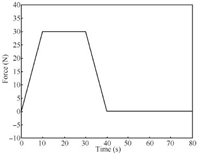
|
Download:
|
| Fig. 2. Human force input. | |
With the proposed control scheme in Section Ⅲ,slave agents keep a rectangle formation with the master robot as shown in Fig. 3. During the time interval $t\in \lbrack 0,80],$ position trajectories of the master and slave agents in $X$-axis and $Y$-axis are given in Fig. 4 and 5,respectively. To show more clearly,formation errors,i.e.,$% \pmb {e}_m=\pmb {q}_{m}-0.25 ({\pmb q}_1+\pmb q_{2}+\pmb q_{3}+\pmb q_{4}),$ $\pmb {e}_1=\pmb q_{1}-\pmb q_{m}+\pmb \gamma _{1},$ $\pmb {e}_2=\pmb q_{2}-\pmb q_{m}+\pmb \gamma _{2},$ $\pmb {e}_3=\pmb q_{3}-\pmb q_{m}+\pmb \gamma _{3}$ and $% \pmb {e}_4=\pmb q_{4}-\pmb q_{m}+\pmb \gamma _{4},$ in $X$-axis and $Y$-axis,are shown in Fig. 6 and 7,respectively. Obviously, formation can be achieved,because all errors approximately converge to zero.
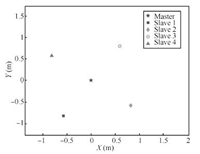
|
Download:
|
| Fig. 3. Positions of master and slaves at t = 60 s. | |
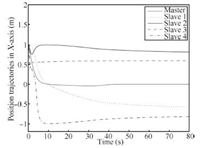
|
Download:
|
| Fig. 4. Position trajectories of master and slaves in X-axis. | |
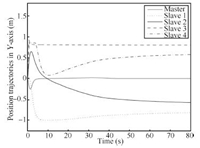
|
Download:
|
| Fig. 5. Position trajectories of master and slaves in the Y-axis. | |
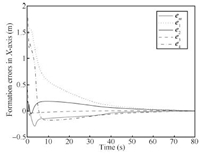
|
Download:
|
| Fig. 6. Formation errors for master and slaves in X-axis. | |
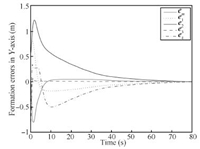
|
Download:
|
| Fig. 7. Formation errors for master and slaves in Y-axis. | |
Next,it is required to analyze the effect of quantization. Fig. 8 shows the original and quantized signals for Joint 1, marked by the dotted and real lines,respectively (to show more clearly,Fig. 9 is the enlarged result of Fig. 8 from 30 to 40 s). Because the quantization error is small,the original and quantized signals look similar. Obviously,the error between the original signal and quantized signal converges to zero with time increasing.
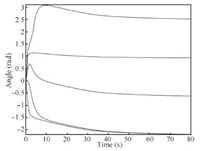
|
Download:
|
| Fig. 8. Original and quantized signals for Joint 1. | |
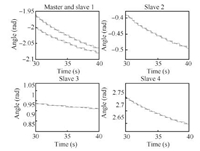
|
Download:
|
| Fig. 9. Enlarged results of Fig. 8 from 30 to 40 s. | |
Additionally,the performance comparison for quantization measurements is provided. To facilitate the identification of comparison,the interval of $% \frac{z}{8}\in \left[-(H+0.5)\Delta ,\text{ }(H+0.5)\Delta \right] $ is broadened,where $H=5$ and $\Delta =0.4.$ The original signal is designed as $z=t-40,$ $t\in [0,\,80].$ Fig. 10 shows the comparison results. In the interval of $\frac{z}{8}\in \left[-(H+0.5)\Delta ,\text{ }(H+0.5)\Delta % \right] $,i.e.,$[-2.2,2.2],$ the quantized signals by using the quantizers in [15, 16, 17] are the same as in this paper. However,in the interval of $% \frac{z}{8}\in (-H,$ $-(H+0.5)\Delta )\cup ((H+0.5)\Delta ,$ $H),$ i.e.,$% (-5,-2.2)\cup (2.2,5),$ the quantization errors in [15, 16, 17] are greater than the error in this paper. The smaller error in this paper is attributed to dynamically adjusted parameter $\mu $, which makes $\frac{z}{\mu}$ keep in the interval of $\left[ -(H+0.5)\Delta ,(H+0.5)\Delta \right] .$ It improves the performance of quantizer and decreases the quantization errors.
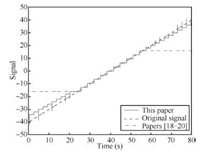
|
Download:
|
| Fig. 10. Quantization measurement comparison. | |
Neglecting the effect of gravitational force,the transparent interaction between the operator and environment is illustrated by the torque error,i.e.,$\pmb {\tau }_{e}=\pmb {F}_{h}-\frac{1}{N}\sum\nolimits_{i=1}^{N}\pmb {F}_{i},$ which is shown in Fig. 11. Because the torque error converges to zero,the transparent interaction between the operator and environment can be achieved,that is,the closed system is stable.
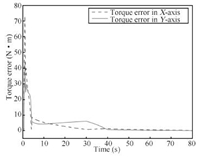
|
Download:
|
| Fig. 11. Torque error between operator and environment. | |
In this paper,"multi-agent system" is applied to the teleoperation system. In addition,a formation controller for single-master-multi-slave teleoperation system with time-varying delays and quantization is presented,where the measurement and control signals are quantized before transmission. Sufficient conditions are obtained to show the controller can stabilize the closed-loop single-master-multi-slave teleoperation system. Meanwhile,the formation and tracking tasks can also be achieved with the controller and the sufficient conditions. By operating the master,humans can teleoperate the overall actions of the slave robots while perceiving combined environmental forces on them. Simulation results are provided to show effectiveness of the main results.
Future research directions include motion coordination and stability analysis for delayed collision avoidance control,dynamic flocking and formation.
| [1] | Pedersen J M, Patel A, Knudsen T P, Madsen O B. Applying 4-regular grid structures in large-scale access networks. Computer Communications, 2006, 29(9):1350-1362 |
| [2] | Chopra N, Spong M W. Bilateral teleoperation:an historical survey. Automatica, 2006, 42(12):2035-2057 |
| [3] | Nuño E, Basañez L, Ortega R. Passivity-based control for bilateral teleoperation:a tutorial. Automatica, 2011, 47(3):485-495 |
| [4] | Ye Y, Liu P X. Improving haptic feedback fidelity in wave-variable-based teleoperation oriented to telemedical applications. IEEE Transactions on Instrumentation and Measurement, 2009, 58(8):2847-2855 |
| [5] | Polushin I G, Liu P X, Lung C H. A control scheme for stable forcereflecting teleoperation over IP networks. IEEE Transactions on Systems, Man, and Cybernetics, Part B:Cybernetics, 2006, 36(4):930-939 |
| [6] | Polushin I G, Liu P X, Lung C H. Projection-based force reflection algorithm for stable bilateral teleoperation over networks. IEEE Transactions on Instrumentation and Measurement, 2008, 57(9):1854-1865 |
| [7] | Nuño E, Ortega R, Barabanov N, Basañez L. A globally stable PD controller for bilateral teleoperators. IEEE Transactions on Robotics, 2008, 24(3):753-758 |
| [8] | Hua C C, Liu P X. Teleoperation over the internet with/without velocity signal. IEEE Transactions on Instrumentation and Measurement, 2011, 60(1):4-13 |
| [9] | Nuño E, Basañez L, Ortega R, Spong M W. Position tracking for nonlinear teleoperators with variable time delay. International Journal of Robotics Research, 2009, 28(7):895-910 |
| [10] | Yang X, Hua C C, Yan J, Guan X P. New stability criteria for networked teleoperation system. Information Sciences, 2013, 233(1):244-254 |
| [11] | Yan J, Guan X P, Luo X Y, Yang X. Consensus and trajectory planning with input constraints for multi-agent systems. Acta Automatica Sinica, 2012, 38(7):1074-1082 |
| [12] | Lin Z Y, Broucke M, Francis B. Local control strategies for groups of mobile autonomous agents. IEEE Transactions on Automatic Control, 2004, 49(4):622-629 |
| [13] | Franchi A, Masone C, Büthoff H H, Robuffo P. Bilateral teleoperation of multiple UAVs with decentralized bearing-only formation control. In:Proceedings of the International Conference on Intelligent Robots and Systems. San Francisco, USA:IEEE, 2011. 2215-2222 |
| [14] | Xu Z H, Ma L, Wu Z Y, Schilling K, Necsulescu D. Teleoperating a formation of car-like rovers under time delays. In:Proceedings of the 30th Chinese Control Conference. Yantai, China:IEEE, 2011. 4095-4101 |
| [15] | Rodríguez-Seda E J, Troy J J, Erignac C A, Murray P, Stipanović D M, Spong M W. Bilateral teleoperation of multiple mobile agents:coordinated motion and collision avoidance. IEEE Transactions on Control Systems Technology, 2010, 18(4):984-992 |
| [16] | Kelly R, Santibáñez V, Loria A. Control of Robot Manipulators in Joint Space. London:Springer, 2005 |
| [17] | Fu M Y, Xie L H. The sector bound approach to quantized feedback control. IEEE Transactions on Automatic Control, 2005, 50(11):1698-1711 |
| [18] | Yang R N, Shi P, Liu G P, Gao H J. Network-based feedback control for systems with mixed delays based on quantization and dropout compensation. Automatica, 2011, 47(12):2805-2809 |
| [19] | Peng C, Tian Y C. Networked H∞ control of linear systems with state quantization. Information Sciences, 2007, 177(24):5763-5774 |
| [20] | Chun H Y, Fei S M, Yue D, Chen P, Sun J T. H∞ quantized control for nonlinear networked control systems. Fuzzy Sets and Systems, 2011, 174(1):99-113 |
 2014, Vol.1
2014, Vol.1 


